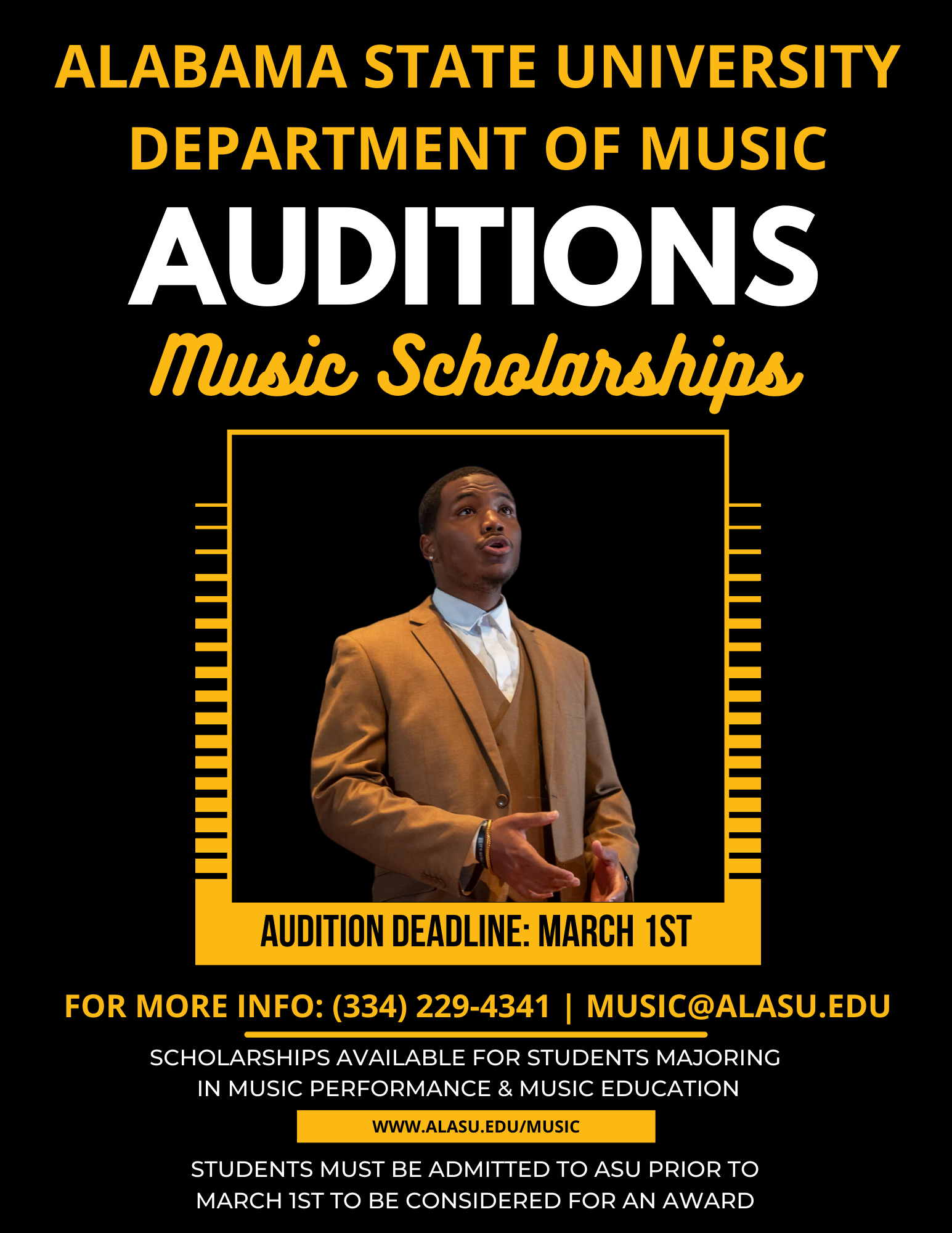auditions
ASU’s Department of Music will hold performance auditions for prospective students who plan to major in music.

In addition to the University's requirements for general admission, each prospective music major must meet entrance requirements for the Department of Music. These requirements include:
- Performance audition
- Diagnostic exam in music theory
These entrance requirements assist the music faculty in assessing the student's musical background, level of proficiency and particular strengths and weaknesses. Students who enter the Department of Music with deficiencies will be required to take more than the minimum number of hours needed to complete degree requirements.
Alabama State University
Department of Music Scholarships
Audition Materials
Students auditioning for admission to the Department of Music must contact the Music
Office at (334) 229-4341 or music@alasu.edu to schedule an audition. ASU music faculty members are available to answer any questions
or concerns you may have about the audition process. In addition to the scales and
studies outlined below, each student will be asked to sight-read and to answer basic
music theory questions. The admission audition will also serve as an audition for
scholarships.
|
VOICE |
Dr. Cordelia Anderson Mr. Tyrone Hayes |
334-604-9179 334-604-9305 |
|
|
Musical selection(s): FROM MEMORY
|
|||
|
PIANO |
Dr. Adonis Gonzalez |
334-604-9190 |
|
|
All white-key scales with both hands using correct fingering: 2 octaves Two pieces from contrasting periods (Baroque, Classical, Romantic) |
|||
|
FLUTE |
Dr. Michael Westmoreland |
334-604-9306 |
|
|
|||
|
OBOE |
Dr. Michael Westmoreland |
334-604-9306 |
mwestmoreland@alasu.edu |
All selections are from David Hite’s book Melodious and Progressive Studies for Oboe, Book 1.
page 10 Number 17 (F Major); page 11 Number 18 (D Minor); page 13 Number 2 (A Minor)
Page 2 Number 3 (G Major); Page 20 Number 9 (Ab Major) – beginning through m. 16 |
|||
|
BASSOON |
Dr. Michael Westmoreland |
334-604-9306 |
mwestmoreland@alasu.edu |
All selections are from J. Weissenborn’s Practical Method for the Bassoon.
Page 88 – Number 14 (F Major) – beginning through measure 16.
Page 38 – Section XVII, 3rd excerpt on page (Andante, 26 measures long) |
|||
|
CLARINET |
Dr. Katrina Phillips |
334-604-8201 |
|
All selections are from David Hite’s book Melodious and Progressive Studies for Clarinet, Book 1.
page 10 Number 17 (F Major); page 11 Number 18 (D Minor); page 13 Number 2 (A Minor)
Page 2 Number 3 (G Major); Page 20 Number 9 (Ab Major) – beginning through m. 16. |
|||
|
SAXOPHONE |
Dr. Michael Westmoreland |
334-604-9306 |
|
All selections are from David Hite’s book Melodious and Progressive Studies for Saxophone, Book 1.
page 10 Number 17 (F Major); page 11 Number 18 (D Minor); page 13 Number 2 (A Minor)
Page 2 Number 3 (G Major); Page 20 Number 9 (Ab Major) – beginning through m.16. |
|||
|
TRUMPET |
Dr. Carly Johnson |
334-229-4341 |
|
|
|||
|
FRENCH HORN |
Dr. Brenda Luchsinger |
334-604-9140 |
|
|
|||
|
TROMBONE & EUPHONIUM |
Dr. Jonathan Houghtling |
334-604-8415 |
jhoughtling@alasu.edu |
|
|||
|
TUBA |
Dr. Jonathan Houghtling |
334-604-8415 |
jhoughtling@alasu.edu |
|
|||
|
PERCUSSION |
Dr. Jessica Williams |
334-604-8414 |
|
All chosen solos must demonstrate your skills and proficiency on snare drum, mallet percussion, and timpani. |
|||